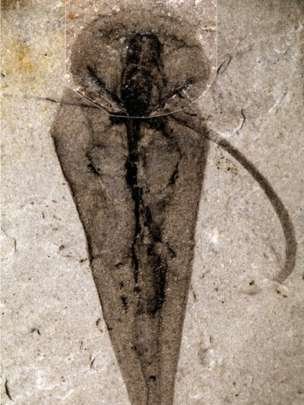Fossil Found Of An Animal That Existed 500 million Years Ago Fills In Blanks On The Tree Of Life, Solving Evolutionary Mystery

A strange animal that lived on the sea floor five hundred million years ago has been added to the tree of life, resolving a long-held mystery. The creature has eluded scientific classification since the primary fossil was discovered one hundred seventy five years past. The extinct hyolith features a conical shell, tentacles for feeding and appendages that acted as "feet". It belongs to an invertebrate group that has animals like the horseshoe worm, say scientists. Joseph Moysiuk, of the University of Toronto, made the discovery when analysing over 1,500 specimens excavated out of rocks in Canada and also the U.S.A.. "Hyoliths are small cone-shaped ocean dwelling animals. they are known from all around the world, mostly from fossils of their shells," he told BBC News. "They appear in the fossil record about 530 million years ago and survived until about 250 million years ago. "But the question of where hyoliths actually fit into the tree of life has been somewhat of a mystery for the last 175 years, since they were first described."
The analysis, revealed within the journal Nature, analysed soft tissue preserved in "very special fossils" from a web site in Canada called the Burgess sedimentary rock. In the past, hyoliths are understood as being associated with molluscs, that square measure common these days and embrace squid, clams and snails. The new analysis suggests the animals square measure really additional closely associated with a special cluster of shell-bearing organisms, called lophophorata, which has brachipods (lamp shells), among others.
Hyoliths were gift from the start of the Cambrian period concerning 540 million years ago, throughout a fast burst of evolution that gave rise to most of the key animal teams. "Being ready to place them on the tree of life, it solves this long palaeontological mystery concerning what these creatures square measure," said Joseph Moysiuk. "We are ready to discover some new options of a awfully previous cluster of fossil animals, and it's allowed U.S.A. to reveal the organic process history of this cluster of animals and wherever precisely they sit on the tree of life."
Dr Martin Smith, of the University of Durham, UK, conjointly worked on the fossils. He said by placing hyoliths in their rightful home and understanding how they lived, scientists currently had a more robust image of life within the ancient seas. This gives AN insight into the impact of mass extinction events like the Permian-Triassic mass extinction, that exhausted most animal life, together with the hyoliths. "Understanding the consequences of such mass extinctions on ecology and variety is especially vital as we tend to obtain to appraise and mitigate the implications of the present mass extinction event caused by human action," Dr Smith said.
This text seems to be copy-pasted from this BBC article with some words being rewritten here and there. Not citing his/her source is a very bad practice and should not be encouraged. I instead recommend you to write one or two paragraphs in your own words and then provide a link to the original article. This is first much more fair with respect to the original author (plagiarism is bad!) and this is also what many people on steemit prefer.
No more plagiarism. Continued plagiarism will earn automatic downvotes. Please return to being an honest member.